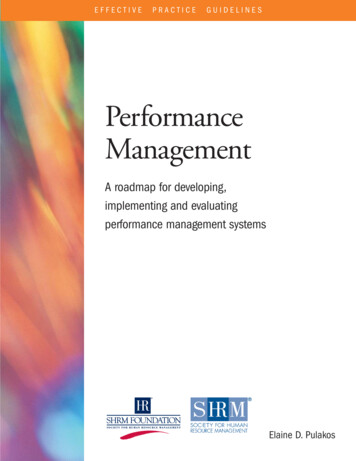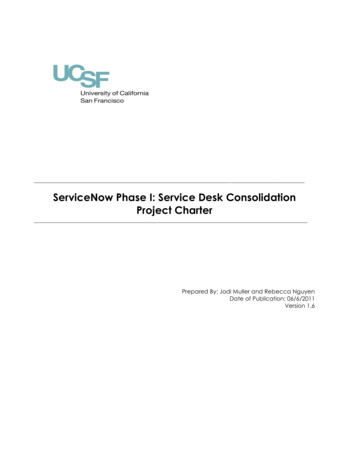
Transcription
EFFECTIVEPRACTICEGUIDELINESPerformanceManagementA roadmap for developing,implementing and evaluatingperformance management systemsElaine D. Pulakos
EFFECTIVEPRACTICEGUIDELINESPerformanceManagementA roadmap for developing,implementing and evaluatingperformance management systemsElaine D. Pulakos
This publication is designed to provide accurate and authoritative information regarding the subject matter covered.Neither the publisher nor the author is engaged in rendering legal or other professional service. If legal advice or otherexpert assistance is required, the services of a competent, licensed professional should be sought. Any federal and statelaws discussed in this book are subject to frequent revision and interpretation by amendments or judicial revisions thatmay significantly affect employer or employee rights and obligations. Readers are encouraged to seek legal counselregarding specific policies and practices in their organizations.This book is published by the SHRM Foundation, an affiliate of the Society for Human Resource Management(SHRM ). The interpretations, conclusions and recommendations in this book are those of the author and do notnecessarily represent those of the SHRM Foundation. 2004 SHRM Foundation. All rights reserved. Printed in the United States of America.This publication may not be reproduced, stored in a retrieval system, or transmitted in whole or in part, in any formor by any means, electronic, mechanical, photocopying, recording, or otherwise, without the prior written permissionof the SHRM Foundation, 1800 Duke Street, Alexandria, VA 22314.The SHRM Foundation is the 501(c)(3) nonprofit affiliate of the Society for Human Resource Management(SHRM). The SHRM Foundation advances the human resource management profession and increases theeffectiveness of HR professionals through research, innovation and research-based knowledge. The Foundation isgoverned by a volunteer board of directors, comprised of distinguished HR academic and practice leaders.Contributions to the SHRM Foundation are tax-deductible.For more information, please contact the SHRM Foundation at 703-535-6020. Online at www.shrm.org/foundation.
Table of ContentsForward . . . . . . . . . . . . . . . . . . . . . . . . . . . . . . . . . . . . . . . . . . . . . . . . . . . . . . . . . . . . vAcknowledgments . . . . . . . . . . . . . . . . . . . . . . . . . . . . . . . . . . . . . . . . . . . . . . . . . . . . viiAbout the Author . . . . . . . . . . . . . . . . . . . . . . . . . . . . . . . . . . . . . . . . . . . . . . . . . . . . . ixEffective Practice Guidelines for Performance Management . . . . . . . . . . . . . . . . . . . . . 1Methodology for Developing Practice Guidelines . . . . . . . . . . . . . . . . . . . . . . . . . . 2Overview of the Performance Management Process . . . . . . . . . . . . . . . . . . . . . . . . 2Performance Planning . . . . . . . . . . . . . . . . . . . . . . . . . . . . . . . . . . . . . . . . . . . 4Ongoing Feedback . . . . . . . . . . . . . . . . . . . . . . . . . . . . . . . . . . . . . . . . . . . . . . 7Employee Input . . . . . . . . . . . . . . . . . . . . . . . . . . . . . . . . . . . . . . . . . . . . . . . . 8Performance Evaluation . . . . . . . . . . . . . . . . . . . . . . . . . . . . . . . . . . . . . . . . . . 9Performance Review . . . . . . . . . . . . . . . . . . . . . . . . . . . . . . . . . . . . . . . . . . . 19Implementation . . . . . . . . . . . . . . . . . . . . . . . . . . . . . . . . . . . . . . . . . . . . . . 21Ensure Alignment with Other HR Systems . . . . . . . . . . . . . . . . . . . . . . . . . . . . 22Get Organizational Members on Board . . . . . . . . . . . . . . . . . . . . . . . . . . . . . . 22Communicate . . . . . . . . . . . . . . . . . . . . . . . . . . . . . . . . . . . . . . . . . . . . . . . . 23Automate . . . . . . . . . . . . . . . . . . . . . . . . . . . . . . . . . . . . . . . . . . . . . . . . . . . 24Pilot Test . . . . . . . . . . . . . . . . . . . . . . . . . . . . . . . . . . . . . . . . . . . . . . . . . . . . 26Train Employees and Managers . . . . . . . . . . . . . . . . . . . . . . . . . . . . . . . . . . . 26Evaluate and Improve . . . . . . . . . . . . . . . . . . . . . . . . . . . . . . . . . . . . . . . . . . 27Legal Considerations . . . . . . . . . . . . . . . . . . . . . . . . . . . . . . . . . . . . . . . . . . . 29Summary and Conclusions. . . . . . . . . . . . . . . . . . . . . . . . . . . . . . . . . . . . . . . . . . . . . 30Sources and Suggested Readings . . . . . . . . . . . . . . . . . . . . . . . . . . . . . . . . . . . . . . . 31iii
ForwardThe SHRM Foundation Board of Directors appreciates how difficult it is for HRpractitioners to access current research findings and incorporate them into their ownhuman resource practices.Human resource professionals juggle multiple responsibilities and do not have time toread long research reports, no matter how beneficial. Realistically, most HR practitioners will seek guidance from research findings only if they are presented in a clear, concise and usable format.To make research more accessible, the SHRM Foundation has created a new seriesentitled Effective Practice Guidelines. The Foundation will publish new reports on different HR topics each year. You are now reading the first report in the series:Performance Management.Here is the series concept: A subject matter expert with both research and practitionerexperience is selected to prepare the guidelines and the author distills the research findings and expert opinion into specific advice on how to conduct effective HR practice.We believe this new product presents relevant research-based knowledge in an easy-touse format. We look forward to your feedback to let us know if we’ve achieved that goal.The author of Performance Management is Dr. Elaine Pulakos, executive vice presidentand director of the Personnel Decisions Research Institutes (PDRI) Washington, D.C.office. Dr. Pulakos is one of the country’s leading experts in performance management,both as a researcher and a consultant, and she has provided the very best guidanceavailable on this topic.The Foundation board recently created a new vision for the organization: “TheSHRM Foundation maximizes the impact of the HR profession on organizationaldecision-making and performance, by promoting innovation, research and the use ofresearch-based knowledge.”We are confident that this new series of Effective Practice Guidelines takes us one stepcloser to making that vision a reality.Herbert G. Heneman III, Ph.D.Director of Research, SHRM Foundation BoardProfessor, School of Business, University of Wisconsin-Madisonv
AcknowledgmentsThe SHRM Foundation wishes to thank the following individuals for reviewing thisreport, providing feedback and helping to shape the finished product:Wayne F. Cascio, Ph.D., Professor of ManagementGraduate School of Business AdministrationUniversity of Colorado at DenverDebra Cohen, Ph.D., SPHRChief Knowledge Development OfficerSociety for Human Resource ManagementHank Hennessey Jr., Ph.D., SPHR, Professor of ManagementCollege of Business and EconomicsUniversity of Hawaii at HiloMark A. Huselid, Ph.D., Associate ProfessorSchool of Management and Labor RelationsRutgers UniversityKathleen McComber, SPHRSr. Director of Human Resources and Org. DevelopmentUniversity of Arkansas for Medical SciencesJames W. Smither, Ph.D., Professor of ManagementSchool of Business AdministrationLaSalle UniversityPatrick M. Wright, Ph.D., DirectorCenter for Advanced Human Resource Studies (CAHRS)Cornell UniversityThis work could not have been completed without the generous support of theSociety for Human Resource Management (SHRM) and the Human ResourceCertification Institute (HRCI).vii
About the AuthorElaine D. Pulakos, Ph.D.Elaine Pulakos is executive vice president and director of theWashington, D.C. office of Personnel Decisions Research Institute(PDRI). PDRI is a premier consulting firm in the field of industrial and organizational psychology. A recognized expert andresearcher in the areas of selection and performance appraisal, Dr.Pulakos has over 15 years experience conducting large-scale jobanalysis, selection, performance appraisal and career developmentprojects.A Fellow of the American Psychological Association (APA) and the Society forIndustrial and Organizational Psychology (SIOP), Dr. Pulakos is a successful authorand has written on the topics of staffing and performance management. She is a pastpresident of SIOP. In addition to authoring numerous publications, Dr. Pulakosrecently co-edited two books: The Changing Nature of Performance: Implications forStaffing, Motivation, and Development with Daniel Ilgen, and ImplementingOrganizational Interventions: Steps, Processes, and Best Practices with Jerry Hedge.Dr. Pulakos has spent her career conducting applied research in public and private sector organizations, where she has designed, developed, and successfully implementednumerous HR systems including staffing, performance management, and career development and training systems. Dr. Pulakos has also been extensively involved in providing expert advice on EEO-related legal matters, serving as an expert witness andadvisor to the Department of Justice, among others. Elaine received her Ph.D. inindustrial and organizational psychology from Michigan State University.ix
Effective Practice Guidelines forPerformance ManagementPerformance management systems, which typically include performance appraisal andemployee development, are the “Achilles’ heel” of human resources management. Theysuffer flaws in many organizations, with employees and managers regularly bemoaningtheir ineffectiveness. A recent survey by Watson Wyatt showed that only three out of10 workers agree that their company’s performance management system helps improveperformance. Less than 40 percent of employees said their systems established clearperformance goals, generated honest feedback or used technology to streamline theprocess. While these results suggest that there may be poorly designed performancemanagement systems in many organizations, it is typically not poorly developed toolsand processes that cause difficulties with performance management. Rather, difficultiesarise because, at its core, performance management is a highly personal and oftenthreatening process for both managers and employees.Managers are reluctant to provide candid feedback and have honest discussions withemployees for fear of reprisal or damaging relationships with the very individuals theycount on to get work done. Employees feel that their managers are unskilled at discussing their performance and ineffective at coaching them on how to develop theirskills. Many complain that performance management systems are cumbersome,bureaucratic and too time consuming for the value added. This leads both managersand employees to treat performance management as a necessary evil of work life thatshould be minimized rather than an important process that achieves key individualand organizational outcomes.Possible Outcomes from Effective Performance ManagementQClarifying job responsibilities and expectations.QEnhancing individual and group productivity.QDeveloping employee capabilities to their fullest extent through effective feedbackand coaching.QDriving behavior to align with the organization’s core values, goals and strategy.QProviding a basis for making operational human capital decisions (e.g., pay).QImproving communication between employees and managers.In spite of the difficulties, performance management is an essential tool for high performing organizations, and it is one of a manager’s most important responsibilities,1
2 Q Performance Managementif not the most important responsibility. Furthermore, done correctly, performancemanagement can result in numerous important outcomes for an organization, itsmanagers and employees. The goal of this booklet is to provide human resource(HR) professionals with useful guidelines for developing and implementing effectiveperformance management systems.Methodology for Developing Practice GuidelinesThe guidelines presented here draw upon the best of the academic research literatureon performance management, the writings of leading performance managementexperts and the experience of highly seasoned practitioners who have successfully ledthe development and implementation of state-of-art performance management systemsin their organizations. A total of 15 professionals from public and private sector organizations were interviewed to learn about the characteristics of the performance management systems they implemented, what factors were most important for success andwhat difficulties were encountered. Information from the research literature, best practice publications and the interviews was melded together to provide a roadmap fordeveloping, implementing and evaluating performance management systems thatreflect demonstrably effective and proven practices.Throughout the paper, many of the guidelines are discussed as being based on eitherresearch or practice. Research-based guidelines are those that can be supported by rigorous and systematic research studies that have been published in peer-reviewed academic journals. Practice-based guidelines are those that reflect a consensus of opinionbased on benchmarking, best practices and the guidance of leading professionals whohave had extensive experience in the field of performance management. The selectionof the references on which this booklet is based was a collaborative effort between theauthor and members of the SHRM editorial board who guided and reviewed thispaper. The citations are not included in the text, but rather appear in the section on“Sources and Suggested Readings” at the end of the paper.Overview of the Performance Management ProcessWhile research and experienced practitioners have identified several characteristics thatare prerequisites for effective performance management systems, there are also manydecisions that need to be made to design a system ideally suited for a given organization’s needs. One such decision is what purpose(s) the system will serve. For instance,performance management systems can support pay decisions, promotion decisions,employee development and reductions in force. A performance management systemthat attempts to achieve too many objectives is likely to die of its own lack of focusand weight. There is no one type of system or set of objectives that is best suited for all
Performance Management Q 3organizations. The purposes for a given performance management system should bedetermined by considering business needs, organizational culture and the system’s integration with other human resource management systems.One important caveat to consider is that while performance management for purposesof decision-making and employee development are certainly related, these two objectives are rarely supported equally well by a single system. When a performance management system is used for decision-making, the appraisal information is used as abasis for pay increases, promotions, transfers, assignments, reductions in force or otheradministrative HR actions. When a performance management system is used fordevelopment, the appraisal information is used to guide the training, job experiences,mentoring and other developmental activities that employees will engage in to developtheir capabilities. Although it is theoretically possible to have a performance management system that serves both decision-making and development purposes well, thiscan be difficult to achieve in practice. In addition, research has shown that the purposeof the rating (decision-making versus development) affects the ratings that areobserved.1 Ratings used for decision-making tend to be lenient, with most employeesreceiving ratings on the high end of the scale. Ratings for developmental purposes tendto be more variable, reflecting both employee strengths and development needs.An example will illustrate why it can be difficult to emphasize equally decision-makingand development within the same system. Managers in this organization evaluate theiremployees and then meet to calibrate their ratings and make reward decisions.Managers then conduct review sessions with every employee to discuss the employee’sperformance, pay increase and stock option grant. Developmental feedback is supposed to be included in the meeting. However, the range of percentage increases andstock options is large, thereby allowing managers to link performance with rewardseffectively. With so much at stake, the majority of the meeting typically focuses on justification by both parties, rather than on how the employee can develop. The climateof the meeting is not conducive to giving and receiving feedback, and employees arereticent to discuss their development needs for fear this will negatively impact theirrewards. Even in the strong performance-based culture of this organization, the decision-making aspect of performance is, by default, given more emphasis.Effective performance management systems have a well-articulated process foraccomplishing evaluation activities, with defined roles and timelines for both managers and employees. Especially in organizations that use performance managementas a basis for pay and other HR decisions, it is important to ensure that all employ-1Greguras, G. J., Robie, C., Schleicher, D. J., & Goff, M. (2003). A field study of the effects of rating purpose on the quality of multisource ratings. Personnel Psychology, 56, 1-21.
4 Q Performance Managementees are treated in a fair and equitable manner. Based on examination of performancemanagement processes in several organizations, most contain some variation of theprocess shown below:Figure 1 Typical Performance Management ProcessDetermination ofOrganization Strategyand ceEvaluationOngoingFeedbackEmployeeInputThe following sections describe each phase of this process in more detail.Performance PlanningAt the beginning of the performance management cycle, it is important to review withemployees their performance expectations, including both the behaviors employees areexpected to exhibit and the results they are expected to achieve during the upcomingrating cycle. Behaviors are important because they reflect how an employee goes aboutgetting the job done—how the individual supports the team, communicates, mentorsothers and so forth. We are all familiar with employees who may achieve exceptionalresults but are extremely difficult to work with, unhelpful or exhibit maladaptivebehaviors at work. Because such behaviors can be extremely disruptive, behavior isimportant to consider in most work situations. On the other hand, an employee canbe extremely helpful, considerate and interpersonally effective, yet never achieve anyimportant results.
Performance Management Q 5Behavioral and results expectations should be tied to the organization’s strategic direction and corporate objectives.2 In fact, if developed and implemented properly, performance management systems drive employees to engage in behaviors and achieveresults that facilitate meeting organizational objectives. For example, if improving customer service is determined to be critical to an organization’s future success, includingcustomer service related expectations and rewards in the performance management system will not only communicate its importance but also promote increases in behaviorsand results related to this area. Similarly, if effective teaming with strategic partners is akey organizational value, the performance management system should hold employeesaccountable for effective collaboration.Behavioral ExpectationsAs we will discuss below, effective performance management systems provide behavioral standards (see page 10 for an example) that describe what is expected of employees in key competency areas. During the performance planning process, managersshould review and discuss these behavioral standards with employees. It is importantfor managers to make sure employees understand how the behavioral standards relateto their specific jobs.Results ExpectationsThe results or goals to be achieved by employees should be tied to the organization’sstrategy and goals. The employee’s development needs should also be taken intoaccount in the goal setting process. Development goals can be targeted either toimproving current job performance or preparing for career advancement. Examplegoals for an employee might be:Q Complete project “X” by time “Y.”Q Increase sales by 10 percent.Q Successfully mentor employee “X” to develop skill “Y.”In some situations, it is difficult to see direct relationships between high-level andsometimes lofty organizational goals and what a particular individual can achieve inhis or her job. To remedy this, organizational goals need to be translated and cascaded into more refined goals and expectations at the unit, team and individual levels.This typically requires a series of meetings where, for example, the highest-level executives first develop division goals that align with the organizational goals. Then, themid-level managers develop unit goals that align with the division goals, followed bymanagers developing group goals that align with unit goals and so on until the organizational goals are cascaded down to individuals. This exercise can be a somewhat2Hillgren, J. S., & Cheatham, D. W. (2000). Understanding performance measures: An approach to linking rewards to the achievement of organizational objectives. Scottsdale, AZ: WorldatWork.
6 Q Performance Managementtime-consuming and difficult process. Depending on the nature of the organization’sgoals, it may be difficult to cascade them down clearly to some jobs, for example,general maintenance and support jobs. Nonetheless, to the extent possible, the mosteffective practice is to establish a hierarchy of goals where each level supports goalsdirectly relevant to the next level, ultimately working toward the organization’sstrategic direction and critical priorities. The value of developing and linking goals atdifferent levels has been extensively written about in the Management by Objectives(MBO) literature.3While goals and expected results can be established for the entire rating cycle, manyemployees are in jobs that are characterized by continual change. Under these circumstances, it may be necessary to set nearer-term goals in order to ensure that they aresufficiently specific and achievable to have positive motivating effects. In addition,feedback should be given and appraisals can be performed as employees reach keymilestones or achieve goals during the rating period.Shown below is a list of guidelines that the research literature has shown to be important for establishing effective goals.4 It is interesting to note that very difficult (butattainable) goals lead to more effective performance outcomes than moderately difficult goals. Research has also shown that employee commitment to goals is criticallyimportant for goal attainment and that employees must feel that they are able toachieve their goals. It is thus important to ensure that employees participate in thegoalsetting process, accept their goals and are motivated to work towards those goals. Itis also important for managers to communicate their willingness to assist employees inachieving their goals by providing guidance and resources, and removing obstacles togoal attainment.Guidelines for Establishing Effective Performance GoalsQGoals must clearly define the end results to be accomplished.QTo the extent possible, goals should have a direct and obvious link to organizationalsuccess factors or goals.QGoals should be difficult, but achievable, to motivate performance.QGoals should be set in no more than three areas—attempting to achieve too manydifferent goals at once will impede success.3Rodgers, R., & Hunter, J. E. (1991). Impact of management by objectives on organizational productivity. Journal of AppliedPsychology, 76, 322-336.4Locke, E. A., & Latham, G. P. (1990). A theory of goal setting and task performance. Englewood Cliffs, NJ: Prentice-Hall.
Performance Management Q 7Ongoing FeedbackDuring the performance planning process, both behavioral and results expectationsshould have been set. Performance in both of these areas should be discussed and feedback provided on an ongoing basis throughout the rating period. In addition to providing feedback whenever exceptional or ineffective performance is observed, providingperiodic feedback about day-to-day accomplishments and contributions is also veryvaluable. Unfortunately, this does not happen to the extent that it should in organizations because many managers are not skilled in providing feedback. In fact, managersfrequently avoid providing feedback because they do not know how to deliver it productively in ways that will minimize employee defensiveness.For the feedback process to work well, experienced practitioners have advocated that itmust be a two-way communication process and a joint responsibility of managers andemployees, not just the managers.5,6 This requires training both managers and employees about their roles and responsibilities in the performance feedback process.Managers’ responsibilities include providing feedback in a constructive, candid andtimely manner. Employees’ responsibilities include seeking feedback to ensure theyunderstand how they are performing and reacting well to the feedback they receive.Having effective, ongoing performance conversations between managers and employees is probably the single most important determinant of whether or not a performance management system will achieve its maximum benefits from a coaching anddevelopment perspective.Research has shown that for feedback to have the most value, it needs to be given inclose proximity to the event.7 It does not help employees to receive feedback nineGuidelines for Providing Feedback EffectivelyQProvide immediate positive and developmental feedback in a private location.QAsk for the employee’s view about what could have been done differently.QBe specific about what behaviors were effective or ineffective.QFocus on what the person did or did not do, not personal characteristics.QCollaboratively plan steps to address development needs.QOffer help in addressing development needs and providing resources.5Wexley, K. N. (1986). Appraisal interview. In R. A. Berk (Ed.), Performance assessment (pp. 167-185). Baltimore: Johns HopkinsUniversity Press.6Cederblom, D. (1982). The performance appraisal interview: A review, implications, and suggestions. Academy of ManagementReview, 7, 219-227.7Wexley, K. N. (1986). Appraisal interview. In R. A. Berk (Ed.), Performance assessment (pp. 167-185). Baltimore: Johns HopkinsUniversity Press.
8 Q Performance Managementmonths after something has happened. And, their performance will likely notimprove on its own while the supervisor is waiting for the end-of-year review sessionto occur. Ongoing feedback can be informal and should occur as part of the dailywork routine. In fact, research has shown that in organizations where employeesreport higher levels of ongoing, informal feedback, performance levels are higher.The table on page 7 presents guidelines that research has found to be important forproviding feedback effectively.8,9,10Employee InputEmployee input has been used effectively in many organizations. It sometimes takesthe form of asking employees to provide self-ratings on performance standards,which are then compared with the manager’s ratings and discussed. However, experienced practitioners have found that this type of process and discussion can lead toincreased defensiveness, disagreements and bad feelings between employees andmanagers, if managers ultimately rate employees less effectively than they have ratedthemselves. An alternative way of collecting employee input is to ask employees toprepare statements of their key results or most meritorious accomplishments at theend of the rating period.Guidelines for Writing Employee AccomplishmentsQInclude the situation or circumstances faced by the employee.QDescribe what specific actions the employee took to achieve results.QDescribe the impact of the accomplishment on the work unit or organization.Employee input has a number of positive results. First, it involves employees in theprocess, enhancing ownership and acceptance. Second, it reminds managers about theresults employees have delivered and how they were achieved. Third, employee-generated accomplishments can be included in the formal appraisal, decreasing managers’writing requirements. Fourth, employee input increases communication and understanding. Managers and employees usually review and discuss the accomplishmentsbefore they become part of the appraisal, resulting in fewer disconnects between themanager’s and the employee’s views of the employee’s contributions. Finally, employeeaccomplishments can be retained and used as input for pay or promotion decisions.8Wexley, K. N. (1986). Appraisal interview. In R. A. Berk (Ed.), Performance assessment (pp. 167-185). Baltimore: Johns HopkinsUniversity Press.9Cederblom, D. (1982). The performance appraisal interview: A review, implications, and suggestions. Academy of ManagementReview, 7, 219-227.10Cawley, B. D., Keeping, L. M., & Levy, P. E. (1998). Participation in the performance appraisal process and employee reactions: Ameta-analytic review of field investigations. Journal of Applied Psychology, 83, 615-633.
Performance Management Q 9Research has shown that employee accomplishments are effective predictors of howsuccessfully employees will perform at higher job levels, and they thus provide usefulinput for promotion decisions.11Performance EvaluationEvaluating BehaviorsToday, many organization
recently co-edited two books: The Changing Nature of Performance: . opment and training systems. Dr. . performance management










